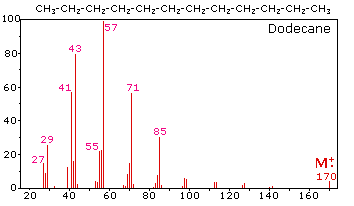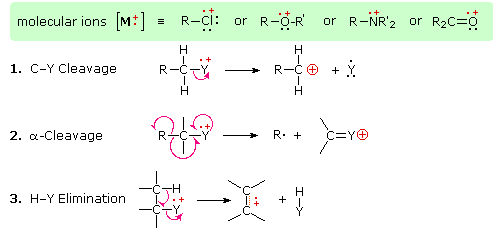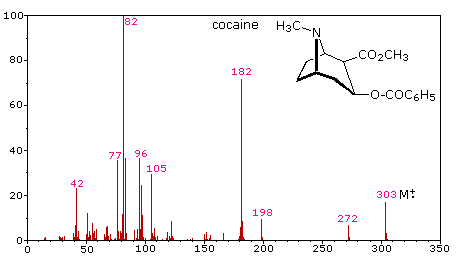There
are a number of ions commonly seen in mass spectrometry that tell you a
little bit about the structure. Just like with anions, there are a
couple of common factors influence cation stability:
However,
in most cases, we will be looking at carbon with a positive charge, and
there are additional factors to distinguish between them
Molecular
orbital calculations suggest that the cation is stabilized through
interaction with neighboring C-H bonds in the alkyl groups.
Specifically, a C-H sigma bonding orbital has symmetry similar to the
empty p orbital on the positive carbon. The lobes on the two orbitals
can overlap such that they are in phase, and that allows electrons to be
donated from the C-H bond to the central, electron-deficient carbon.
Formally, there is a bonding interaction and an antibonding interaction
between these two orbitals. Since one of these orbitals is empty, the
antibonding combination remains unoccupied. The bonding combination is
populated, however, and since it is lower in energy than either the p
orbital or the C-H sigma bond (all bonding combinations are lower in
energy than the orbitals that combine to form them), there is a net
decrease in energy.
Fragmentation Patterns
The fragmentation of molecular ions into an assortment of fragment ions
is a mixed blessing. The nature of the fragments often provides a clue
to the molecular structure, but if the molecular ion has a lifetime of
less than a few microseconds it will not survive long enough to be
observed. Without a molecular ion peak as a reference, the difficulty of
interpreting a mass spectrum increases markedly. Fortunately, most
organic compounds give mass spectra that include a molecular ion, and
those that do not often respond successfully to the use of milder
ionization conditions. Among simple organic compounds, the most stable
molecular ions are those from aromatic rings, other conjugated
pi-electron systems and cycloalkanes. Alcohols, ethers and highly
branched alkanes generally show the greatest tendency toward
fragmentation.

The mass spectrum of dodecane on the right illustrates the behavior
of an unbranched alkane. Since there are no heteroatoms in this
molecule, there are no non-bonding valence shell electrons.
Consequently, the radical cation character of the molecular ion (m/z =
170) is delocalized over all the covalent bonds. Fragmentation of C-C
bonds occurs because they are usually weaker than C-H bonds, and this
produces a mixture of alkyl radicals and alkyl carbocations. The
positive charge commonly resides on the smaller fragment, so we see a
homologous series of hexyl (m/z = 85), pentyl (m/z = 71), butyl (m/z =
57), propyl (m/z = 43), ethyl (m/z = 29) and methyl (m/z = 15) cations.
These are accompanied by a set of corresponding alkenyl carbocations
(e.g. m/z = 55, 41 &27) formed by loss of 2 H. All of the
significant fragment ions in this spectrum are even-electron ions. In
most alkane spectra the propyl and butyl ions are the most abundant.
The presence of a functional group, particularly one having a
heteroatom Y with non-bonding valence electrons (Y = N, O, S, X etc.),
can dramatically alter the fragmentation pattern of a compound. This
influence is thought to occur because of a "localization" of the radical
cation component of the molecular ion on the heteroatom. After all, it
is easier to remove (ionize) a non-bonding electron than one that is
part of a covalent bond. By localizing the reactive moiety, certain
fragmentation processes will be favored. These are summarized in the
following diagram, where the green shaded box at the top displays
examples of such "localized" molecular ions. The first two fragmentation
paths lead to even-electron ions, and the elimination (path #3) gives
an odd-electron ion. Note the use of different curved arrows to show single electron shifts compared with electron pair shifts.

The charge distributions shown above are common, but for each
cleavage process the charge may sometimes be carried by the other
(neutral) species, and both fragment ions are observed. Of the three
cleavage reactions described here, the alpha-cleavage is generally
favored for nitrogen, oxygen and sulfur compounds. Indeed, in the
previously displayed spectra of 4-methyl-3-pentene-2-one and N,N-diethylmethylamine
the major fragment ions come from alpha-cleavages. Further examples of
functional group influence on fragmentation are provided by a selection
of compounds that may be examined by clicking the left button below.
Useful tables of common fragment ions and neutral species may be viewed
by clicking the right button.
The complexity of fragmentation patterns has led to mass spectra
being used as "fingerprints" for identifying compounds. Environmental
pollutants, pesticide residues on food, and controlled substance
identification are but a few examples of this application. Extremely
small samples of an unknown substance (a microgram or less) are
sufficient for such analysis. The following mass spectrum of cocaine
demonstrates how a forensic laboratory might determine the nature of an
unknown street drug. Even though extensive fragmentation has occurred,
many of the more abundant ions (identified by magenta numbers) can be
rationalized by the three mechanisms shown above. Plausible assignments
may be seen by clicking on the spectrum, and it should be noted that all
are even-electron ions. The m/z = 42 ion might be any or all of the
following: C
3H
6, C
2H
2O or C
2H
4N. A precise assignment could be made from a high-resolution m/z value (next section).
Odd-electron fragment ions are often formed by characteristic
rearrangements in which stable neutral fragments are lost. Mechanisms
for some of these rearrangements have been identified by following the
course of isotopically labeled molecular ions.






























